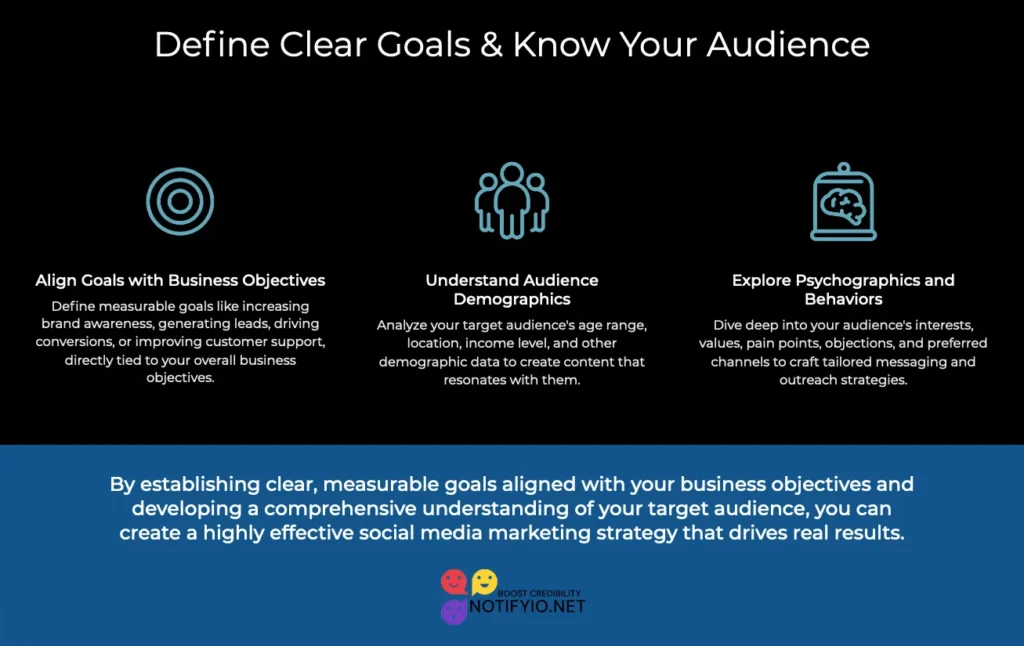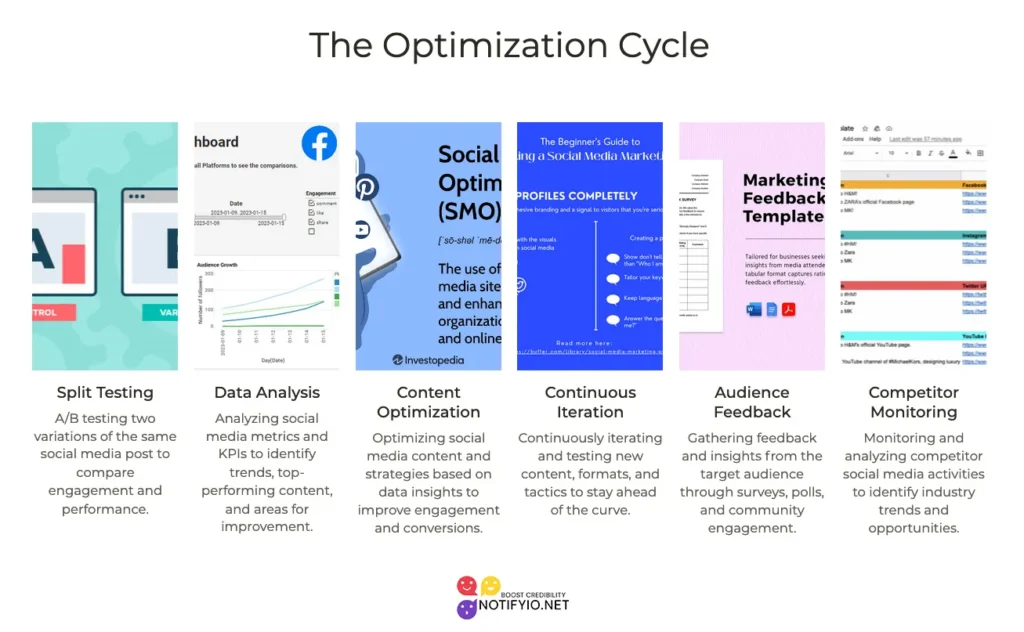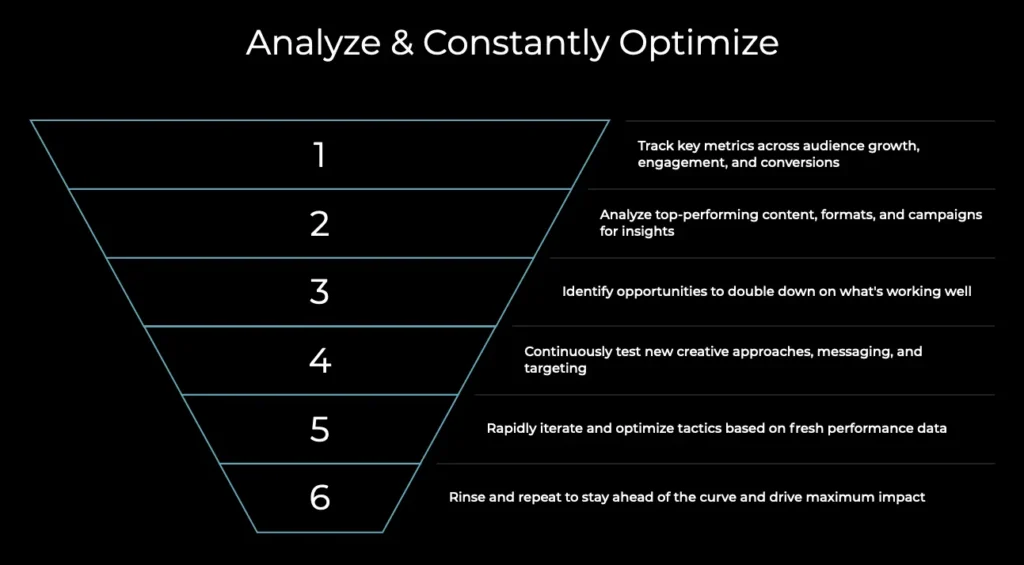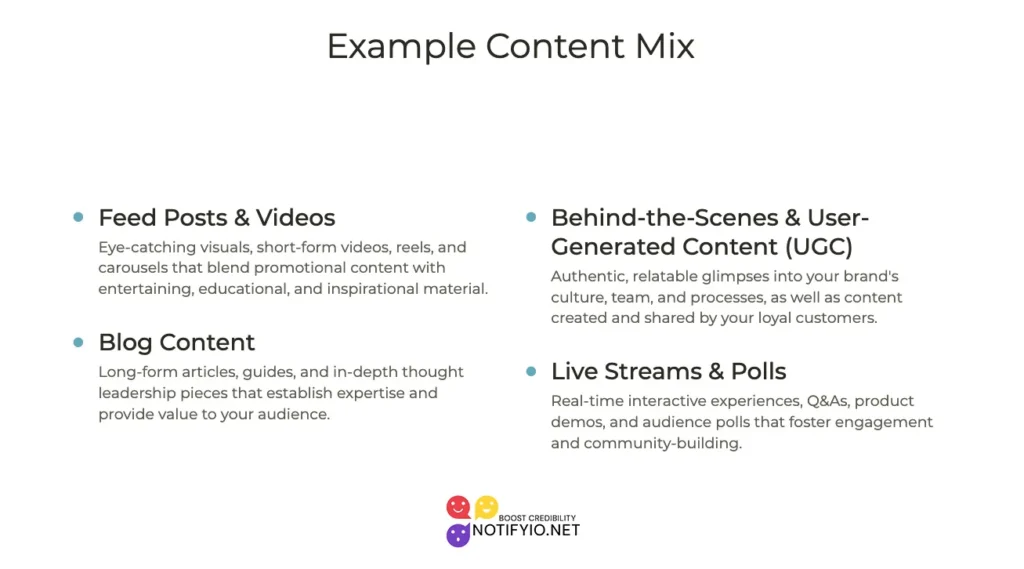Let’s face it – in 2024, if you’re not killing it on social media, you’re getting left in the dust by your competitors. Social platforms are no longer just for sharing memes and vacation pics. They’ve become powerful marketing channels. They can supercharge your brand’s growth.
But simply having accounts isn’t enough. You need a good, data-driven social media marketing strategy. It’s key for unlocking the potential of these platforms. I’m a marketing pro. I’ve helped many brands crush social media. Here, I’ll break down the 5 keys you need.
Let’s dive in!
Key Takeaways
- Define clear goals and deeply understand your target audience
- Create a content calendar with a consistent mix of engaging content types
- Prioritize community engagement by responding promptly and running campaigns
- Leverage influencers strategically to drive awareness and credibility
- Constantly analyze performance and optimize your strategy for better results

1. Define Your Goals & Target Audience
“If you don’t know where you’re going, any road will get you there.” This classic Lewis Carroll quote is so true. It applies to social media marketing. Before you dive in, you need to define your goals. You also need to deeply understand your audience.
What are your goals?
Are you looking to:
- Increase brand awareness and reach
- Generate leads and drive conversions
- Provide top-notch customer support
- Something else entirely?
Don’t just go with vanity metrics like follower counts. Get specific with measurable goals that directly impact your business objectives.
For example, I consulted for a B2B SaaS company. Their main goal was using social media to generate leads. They aimed to do this through educational content. This focused our entire strategy.
Who is your target audience?
You need to have a crystal clear picture of who your ideal customer is across key demographics like:
- Age range
- Location
- Income level
- Interests & behaviors
But also dive deeper into their psychographics. Also, learn their pain points, objections, and the channels they use most. Maybe your audience is mostly business professionals in their 30s. They work in tech and are active on Twitter and LinkedIn.
Knowing your audience well lets you make content they relate to. It allows you to show up with the right messaging on the right platforms.
2. Develop a Strategic Content Plan
I often tell clients – “Content is the bacon bits of the social media world.” You simply can’t succeed without a steady stream of engaging, strategic content.
To stay ahead of the curve, you need to develop a comprehensive content plan that covers:
- A consistent posting schedule across channels – Don’t just post whenever you feel like it. Map out a cadence for publishing that maintains visibility. My general rule is 1-2 feed posts per day plus consistent Stories.
- A varied content mix – Variety is the spice of life, and the same applies to your social content. Incorporate a healthy mix of different content types like:
- Feed posts & reels/videos
- Blog content & long-form articles
- Behind-the-scenes, user-generated, and lifestyle content
- Live streams, Q&As, and polls

The possibilities are endless! For example, I worked with an outdoor apparel company. They mixed product shots and promo content. These included great photos and videos from hiking and adventures. This balance of value and promotion kept their audience engaged.
- A meticulous content calendar – Randomly winging it is a recipe for disaster. Use a tool like Google Calendar, Asana, or CoSchedule to map out your content in advance. This allows you to plan for major marketing moments, cultural events, and promotions.
Social media moves fast. So, an organized, thoughtful content plan is crucial. It allows you to stay one step ahead while maintaining quality and consistency.
3. Prioritize Community Engagement
Let’s get one thing straight. Social media isn’t a bullhorn to blast your audience with promos. It’s an interactive dialog that requires consistent engagement.
Respond promptly to comments & DMs
One of the biggest engagement killers is radio silence from brands on social. If someone takes the time to comment on your post or send a DM, you better respond! Even if it’s just acknowledging it for now, not leaving people hanging is huge.
I’m a big believer in the 24-hour response rule for comments and DMs. Any longer and you start to lose people’s attention and interest.
Run engaging campaigns and activations
Of course, effective engagement goes far beyond just responding. You need to create chances for people to actively join with your brand on social media.
For example, I worked with an athletic apparel brand. They often posted simple prompts like “What’s your favorite workout song?”” and they’d engage with every serious response. They also ran contests and giveaways. These required things like uploading a video, using a branded hashtag, or getting friends to engage.
These types of activations really help drive community and connection on social media.

Incentivize and repurpose user-generated content (UGC)
Another powerful engagement approach is to incentivize and re-share UGC. For instance, customers posting photos with your product or employees sharing behind-the-scenes looks.
You can run simple contests for people to share their content and offer a freebie or discount for featured submissions. UGC builds immense credibility and social proof. Create experiences worth sharing. Customers will quite literally become your biggest advocates and influencers.
Prioritizing engagement is beautiful. It feeds the algorithm. This increases organic visibility and brand loyalty. It takes your social strategy to a whole new level.
4. Leverage Influencers Strategically
No one can deny it. Influencer marketing is key to social media success. But there’s a right and a wrong way to utilize influencers for your brand.
Identify relevant, authentic influencers
The first step is finding the right influencers. They should be a natural fit for your brand’s personality and audience. An influencer doesn’t need millions of followers to be impactful – often the opposite is true.
I always recommend using tools like HypeAuditor. They vet influencers based on real engagement rates in your niche. Look for influencers who make good, niche-relevant content. They have high engagement compared to their following.

Foster long-term partnerships vs. one-off promotions
Many brands miss the mark. They treat influencer marketing as a transaction. They use one-off promotional posts. Instead, I suggest finding 5-10 ideal influencers. Then, explore long-term, mutually-beneficial partnerships and affiliate programs.
This creates a deeper, more authentic connection versus just paying for “lego-style” integrations. It also lets you use the influencer’s trusted voice and storytelling. You can use them over time.
Allow influencers creative freedom
The whole point of influencer marketing is to have authentic personas promote your product in their own voice and style. So I always tell clients not to put influencers in a restrictive box.
Give loose guidelines and direction. But, allow your influencers the freedom and flexibility to create their content and captions. You want it to feel natural to their audience.
Done right, influencers can fuel your brand’s growth. They give credible advice and have niche authority.
5. Analyze & Constantly Optimize
The best social media strategies are never “set it and forget it.” You need to have a process for consistently analyzing performance and optimizing tactics based on real data.
Key metrics to measure
You’ll want to track key performance indicators (KPIs) across the core areas of:
- Audience growth: Follower growth, profile visits, impressions, reach
- Engagement: Likes, comments, shares, saves, DM volume
- Conversions: Website clicks/traffic, sales/revenue attributed to social
Depending on your goals, some metrics will take priority. For example, if awareness is the primary objective, audience growth and reach metrics are critical. If driving sales is the focus, conversion tracking will be most important.
Identify insight and opportunities
Once you have a solid data set, you have executed your strategy for 2-3 months. Look closely at your best content and campaigns. What themes, messaging, and creative resonated best with your audience? Which content types and styles drove the highest engagement and conversion rates?
Use those insights to inform future content on the topics and formats that clearly work. Also analyze what fell flat so you can adjust and optimize accordingly.
Continuously test and iterate
A key mantra for social media is “test everything.” You should always be testing new tactics. Try creative approaches, content styles, and targeting parameters. Things always evolve. So, even your best workers will get tired and need a break.
For example, maybe your lifestyle videos are doing great. They have high engagement and reach. But 6 months later, try testing some live video or a new editing style. Be proactive about keeping things fresh and optimized based on your data insights.
Winning brands on social media are relentless. They never rest on their laurels. Following this optimization approach will keep you nimble and ahead of the curve.

FAQ
What social media platforms should I focus on?
This completely depends on your specific audience and niche. In general, I’d recommend using 2-4 core platforms. Expand from there based on how much content you can make and how well it does. The major platforms are Meta, Instagram, Twitter, LinkedIn, Pinterest, and TikTok. They are essential for most consumer brands.
How much should I pay for influencer marketing?
Influencer costs vary a lot. They depend on the creator’s following count, niche, and engagement rates. Some influencers charge per promotional post. Others join affiliate and commission-based programs. When starting out, you can expect to pay between $100-$1,000 per post for influencers with 10,000-100,000 followers. But I recommend prioritizing smaller, niche-specific influencers. They have high engagement rates. This is better than just paying for reach.
How often should I post on social media?
There’s no one-size-fits-all answer, but a general rule of thumb is to post:
- 1-2 feed posts per day on Meta/IG
- 3-5 tweets per day on Twitter
- 1-2 posts per day on LinkedIn
- Several times per week on visual platforms like Pinterest and TikTok
Test different frequencies and analyze the data. More importantly, focus on consistency rather than volume.
How do I get started with social media marketing?
Follow this simple checklist:
- Define your goals and audience
- Research your competitors’ strategies
- Set up accounts and optimize profiles
- Develop a consistent branding style
- Create a strategic content calendar
- Actively engage with your community
- Analyze performance and keep iterating
What are the best social media content types?
The most engaging content types span:
- Video and motion graphics
- High-quality visuals and photography
- Carousels and mixed-media posts
- Live video and Q&As
- User-generated and behind-the-scenes content
- Entertaining memes and trends

The “best” format depends on your goals, audience, and what works best for your account. Mix it up and test constantly.
Final Thoughts
There’s no one path to mastering social media marketing. But, these 5 keys give the base every brand needs. They help build an engaged audience and drive real business impact.
Commit to clearly defining your goals and understanding your audience. Invest in developing a varied, high-quality content strategy. Prioritize two-way engagement and community-building. Strategically leverage influencers for awareness and advocacy. Most importantly, focus on analyzing your performance. Do this so you can keep improving your tactics.
Social media has become one of the most powerful channels. It can grow your brand’s visibility and revenue. By following these battle-tested keys, you’ll soon join the elite brands. They are absolutely crushing it in 2024 and beyond.
Are you ready to take your social media strategy to new heights? Let me know your biggest challenges or questions in the comments!



Leave a Reply